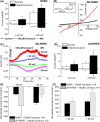Transient receptor potential vanilloid 3 expression is increased in non-lesional skin of atopic dermatitis patients
- PMID: 35038353
- PMCID: PMC9303285
- DOI: 10.1111/exd.14530
Transient receptor potential vanilloid 3 expression is increased in non-lesional skin of atopic dermatitis patients
Abstract
TRPV3 (transient receptor potential vanilloid 3) is a pro-inflammatory ion channel mostly expressed by keratinocytes of the human skin. Previous studies have shown that the expression of TRPV3 is markedly upregulated in the lesional epidermis of atopic dermatitis (AD) patients suggesting a potential pathogenetic role of the ion channel in the disease. In the current study, we aimed at defining the molecular and functional expression of TRPV3 in non-lesional skin of AD patients as previous studies implicated that healthy-appearing skin in AD is markedly distinct from normal skin with respect to terminal differentiation and certain immune function abnormalities. By using multiple, complementary immunolabelling and RT-qPCR technologies on full-thickness and epidermal shave biopsy samples from AD patients (lesional, non-lesional) and healthy volunteers, we provide the first evidence that the expression of TRPV3 is markedly upregulated in non-lesional human AD epidermis, similar to lesional AD samples. Of further importance, by using the patch-clamp method on cultured healthy and non-lesional AD keratinocytes, we also show that this upregulation is functional as determined by the significantly augmented TRPV3-specific ion current (induced by agonists) on cultured non-lesional AD keratinocytes when compared to healthy ones.
Keywords: TRPV3; atopic dermatitis; inflammatory skin diseases; keratinocytes.
© 2022 The Authors. Experimental Dermatology published by John Wiley & Sons Ltd.
Conflict of interest statement
TB provides consultancy services to Phytecs, Inc. (Los Angeles, CA, USA) and Monasterium Laboratory (Münster, Germany) who had no role in conceiving the study, designing the experiments, writing the manuscript or in the decision to publish it. The other authors state no conflict of interest.
Figures


References
Publication types
MeSH terms
LinkOut - more resources
Full Text Sources

